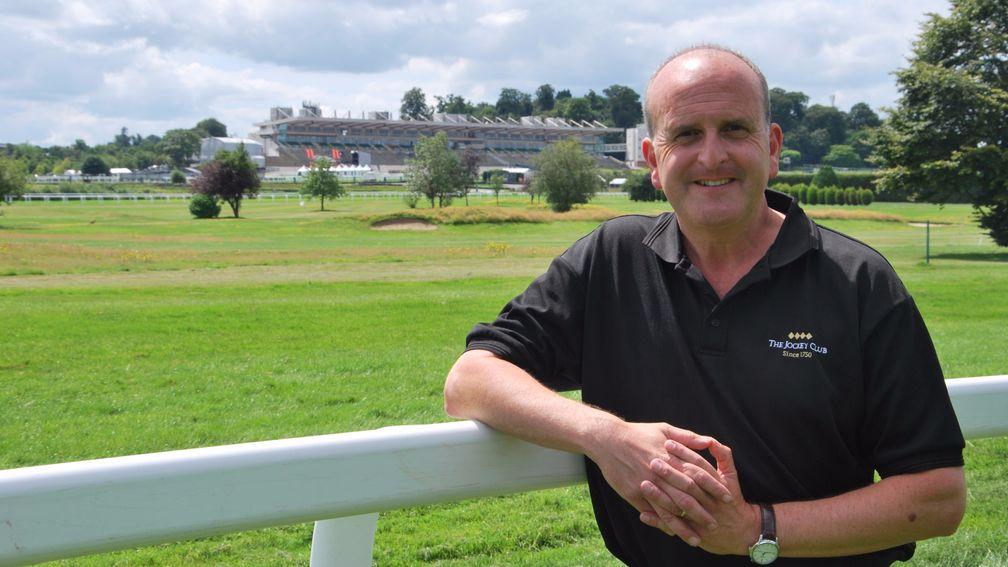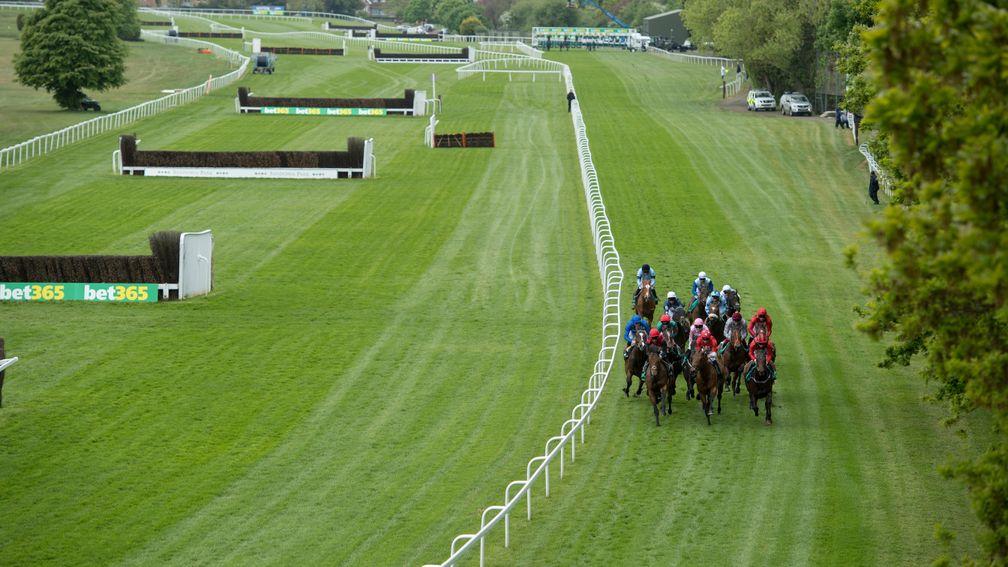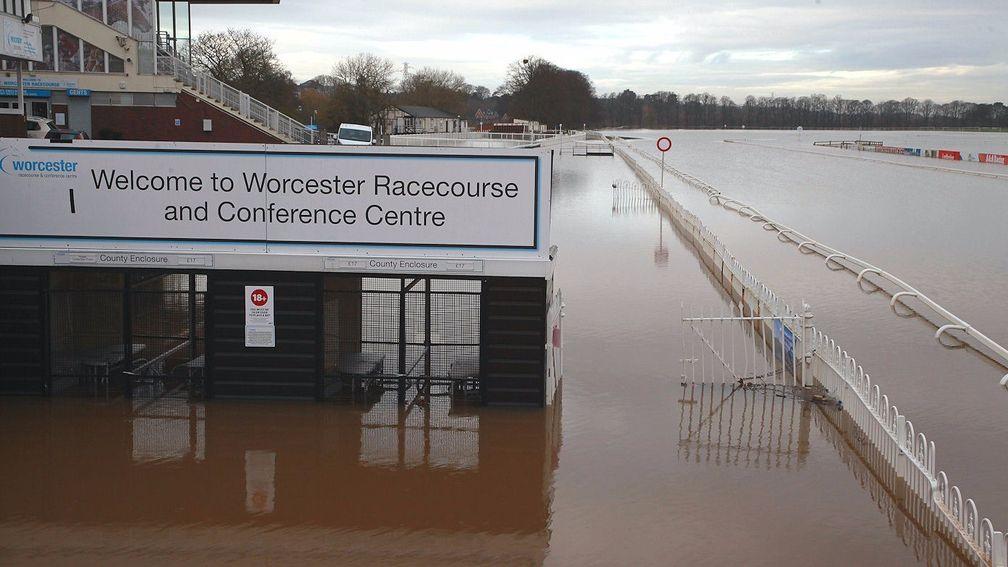Steve Dennis speaks to Sandown clerk Andrew Cooper about his role

First published on Monday, August 8, 2016
He looks up to the sky, not for the first time, not for the last time. There’s a swathe of blue to the west, a few light grey clouds to the east, a gentle breeze rearranging the pattern, no celestial alarms in sight. “I suppose I’m a bit obsessed with the weather,” says Andrew Cooper.
Cooper is clerk of the course at Sandown. Last Thursday 45 horses galloped over the Esher slopes, 180 hooves tearing at the turf, and in two days’ time the track will have to be in good order so that 44 more (176 hooves) can take their turn. Cooper stands at the winning post, his right-hand man Craig Williamson on his left, and begins the familiar patrol, another circuit of the one-mile-five-and-a-half-furlong circuit he knows better than the back of his hand. The trail of the last horse to pass this way is visible in the grass at his feet.
“It was a hot week, the course had had two days’ racing and we wanted to get water on before the weekend, so we started a circuit of irrigation straight after racing on the Thursday,” says Williamson, regional estates manager for the Jockey Club, Sandown’s head groundsman, in earthier terms. “And there was a hot weekend coming up so we put on 10mm of water just to get it back in shape, enough to get us through the weekend.”
First the water went down, then the holes were filled. On Friday morning the slow-moving army of treaders-in roamed the track, repairing the damage hole-by-hole, the manual approach the only way to do the job satisfactorily. It’s turf husbandry at its most fundamental.
“We had a dozen treaders out there alongside our nine full-time groundstaff,” says Williamson. “It took around seven tons of soil to fill all the holes – it’s a sand-soil mix – and then 30kg of grass seed went on top. If that sounds like a lot, after a jumps meeting in the middle of winter it might take 25 tons to repair the whole racecourse.
“Then we mowed the grass – it gets a cut on Monday, Wednesday and Friday throughout the summer, keeping to the industry specification of four inches for Flat racing, although it’s left a little longer for the jumps. After that we moved around a mile of plastic rail – it was a busy day.”
Cooper glances at the sky again as he walks on around the bend and downhill towards the Eclipse start, passing a boom irrigator spraying out water. He has the figures to hand, but in the back of his mind there is the ceaseless shuffling of plans, of opinions, of measure and countermeasure.
“It takes an hour and a half, per furlong, to put down 10mm of water,” he says. “We’re trying to produce ground on the faster side of good and on the better side of good to firm. Somewhere in the middle. The BHA says we should aim for good to firm – genuine good to firm is proper summer Flat-racing ground and the job is to avoid it being quicker than that.
“People think ‘oh, the clerk can’t wait to get his watering can out’, but it’s not like that – Craig and I spend a lot of time debating the watering situation. The thought process is quite tiring, really. We had a discussion on Sunday after looking at the weather forecast, then we were here to walk the track first thing this morning and had another long conversation about irrigation. I never stop thinking about it.
“I updated the going at 7am – it’s declaration day – and we agreed a watering strategy for the next 24 hours, which we’ll review tomorrow. One important thing to remember is that we’re not predicting – we’re reporting. We say what the going is at the time, not what we think it will be on raceday, so when trainers declare for the meeting they know what the ground is.
“We’ve had such a run of good to firm recently that I’ve received fewer calls about the going than at other times. When things are more uncertain I might get a dozen calls of a morning.”
Those calls will be familiar to any clerk. The debate about whether to water and how much to water is a summer constant, with trainers keen that fast-ground horses get the conditions they need and clerks charged with providing it while at the same time ensuring that the balance doesn’t tip too far away from a safe surface. Cooper, with 22 years’ experience of that debate, is sanguine regarding its nuance.
“In the past there were trainers opposed to watering full stop, really. There was the old rule about only watering to keep the grass growing, but now the BHA says we should water to ensure the ground is no quicker than good to firm. For a two-day meeting, like last week, I’d aim to start the first day on ground closer to good in the knowledge that it’ll end up a lot closer to good to firm.
“A showery forecast is the most challenging, because of its vague nature. Another difficult scenario is a dry forecast all week with a threat of thunderstorms the day before racing. The thing to do is leave ourselves in a position where whatever happens, we won’t be far wrong – water enough so we won’t be in trouble if it doesn’t rain, but not so much that we’ll be in trouble if it does.
“You can only work with the forecasts you’re given – we deal with the Met Office and one other main supplier. All we can do is make the best decisions with the information we have at the time, using all our experience and feel for the racecourse. And generally, forecasts are better now regarding the volume and timing of rain. Mind you, there are times when I just sit there watching the weather radars most of the evening – gripping stuff.”
That draws a grin of recognition from Williamson, a 16-year veteran of Sandown. By now we’re halfway along the back straight, a position that lends itself to further insight. Williamson pulls a piece of paper from his pocket, a map of the course showing the soil type at any given point. There is little consistency – the part of the course we’ve just walked contains the heaviest, most clay-ey ground, but halfway down the back straight is a patch of the lightest, sandiest soil on the whole course. The five-furlong straight starts sandy and finishes in clay soil, while the home straight varies throughout its length.

Different soil types retain water to different degrees, which is another factor for Cooper and Williamson to bear in mind as they formulate a plan of action, of irrigation. As we reach the seasonal remnants of the Railway fences a London train aptly whistles by, drowning out the start of Cooper’s illustration of how the rail has been moved to provide fresh ground for each meeting, something else that occupies the clerk’s mind long-term as well as short-term.
“There’s the inner rail, the one that’s surveyed and used for the precise race distances, and we can move the rail positions from that point, as much as eight yards out in certain places on straights.
“For the last meeting the rail was a fair way out, and now we’re moving in towards the inner configuration while pushing the bend out a bit. I’m always looking two or three meetings ahead when it comes to rail positions – this week is done and dusted, but we’re always thinking about where the rails will have to be for forthcoming meetings, so we can tailor our race programme accordingly.”
The bends are watered by means of piping laid on the turf – for greater precision than that offered by the boom irrigator – and Cooper is careful to ensure that the relatively tight bend into the home straight is a little bit easier, offers a little more traction, to that end spiking the area on raceday to rough up the surface a little. “We’d never water a bend between two consecutive days – we’d make sure there was initially enough give in it to see us through both days. Mind you, the easier the ground the more damage you do to it.”
We set sail for home up the straight. Given the settled weather pattern it was a quiet weekend for the groundstaff, although they’re all out there now, strimming anything that’s growing where it shouldn’t, attending to the boom irrigator, taking GoingStick readings. Ah, the GoingStick.
“I find the GoingStick a good guide, a useful tool,” says Cooper. “It’s good for comparisons at one course but the readings don’t translate to other tracks. I’m aware of its shortcomings but I certainly wouldn’t be too dismissive of it, and having the same person using it each time helps with the consistency.
“Trainers? It’s very rare for one to phone and ask about the GoingStick reading.”
Later today the course will be mown again and tomorrow will be all about aiming to maintain the conditions as raceday looms. It’ll be the sixth meeting at Sandown during July – “That’s a lot for this course” – and although Cooper’s little bit of England is not as pristine as he’d like given the hectic schedule, the challenge of the job still casts its spell over him.
“It’s a hugely satisfying job. At the end of a day’s racing, or even after the first race, the point where you think ‘yeah, got that right, this is lovely ground, safe, the plan worked’ makes it all worthwhile, all the sleepless nights and early mornings, the pressure, the decision-making and careful thought, the monitoring of weather we have no control over.” His gaze drifts skyward yet again, the old and irrepressible reflex. Nothing has changed, which is good – no, make that good to firm.
‘Jump racing can be more challenging for us’
Sandown’s role as a dual-purpose racecourse adds the element of variety to clerk of the course Andrew Cooper’s role while at the same time providing fresh challenges. The preparation of the Flat track and the jump circuit – for consecutive days at the end of April, too – is not dissimilar, but each has individual requirements.
“Generally speaking, jump racing is more challenging for us,” he says. “The course sustains a greater degree of damage and it doesn’t recover through the winter – the grass doesn’t grow.
“What we have in November, at the beginning of the season, is what we come out with in March. We can’t do anything about that.
“The hardest part of the summer programme is the irrigation issue and the sheer time it takes up. If we need to put on a lot of water it can take two days to cover the whole Flat track, including the five-furlong straight.”
When the going goes wrong
The perils and pitfalls of maintaining a track
Most of the time all goes well with the going, but of course there are occasions when calamity strikes, a tale of the unexpected, the unforeseen, the downright unusual
Heartbreak ridges The home straight at Yarmouth has endured more than its fair share of misfortune recently. Around £300,000 was spent on smoothing out ridges on the racing surface at the seaside track – with a large number of meetings lost while the remedial work took place – and even when the track was back billiard-table smooth there were pitfalls in store. Heavy rain fell on good to firm ground, making the bends sufficiently slippery to fell Passover and Oisin Murphy. Further meetings were lost while further improvements were made; Yarmouth is on safer ground now.
Water, water everywhere Poor Worcester. Its idyllic location on the banks of the silvery Severn leaves it vulnerable in times of heavy rainfall, when the silvery Severn spills over those banks and floods the racecourse (which stands on a flood plain). Many meetings have been lost with the track under feet of water, and photographers are always keen to capture an image of a canoeist dodging ducks as he rows past the winning post. They say little fish are sweet; not when they need to be removed from the sodden turf by the barrowload after the waters recede.

Bug in the system Chepstow and Goodwood have been beset by insect infestation in recent years, with the greedy larvae of the insects in question feasting on the grass roots at a vital time in the spring and preventing growth, leading to unstable ground and lost meetings while their elimination is pursued. No long-term damage is done but reoccurrence is always a possibility.
Holes in the ground As the runners in the 1989 Portland Handicap left the stalls, all seemed in place for an exciting race. Two furlongs out, excitement turned to horror when the ground gave way under Madraco’s feet, causing him to fall and bringing down Tolo and Pendor Dancer. Paul Cook and Ian Johnson never rode again after their heavy falls, and two days later, when further holes opened up and another horse came down, the meeting was abandoned and the St Leger transferred to Ayr. The blame was laid at the door of recent drainage work, after which the soil had failed to knit together sufficiently. In 2001 the Punchestown festival had to be abandoned weeks ahead of the event. Just as racing was given the all-clear to resume following the foot-and-mouth crisis, the issue of holes in the Punchestown turf intervened. Complications surfaced following the installation of a new drainage system the previous year yet the track was still deemed unfit for purpose the following spring.
Flat denial Problems with the ground led to Warwick ditching their Flat programme and going all-jumps in 2014. The shift was precipitated by precipitation – rain falling on fast ground on a closely-mown bend that had always been notorious for its tricky camber, and causing the fatal fall of Artful Lady. Certain Flat jockeys declined to ride at Warwick because of the camber, notably Ryan Moore, and as of now no Flat jockeys will ever ride there again.
Racing Post form experts on the importance of the going for betting
Members can read the latest exclusive interviews, news analysis and comment available from 6pm daily on racingpost.com
Published on 25 August 2017inRP Classics
Last updated 17:08, 25 August 2017